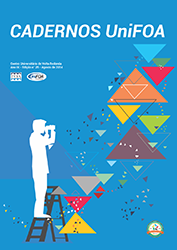TECHNICAL-ECONOMIC FEASIBILITY STUDY OF A THERMOSOLAR DESSALINATION PROTOTYPE FOR THE SEMI-ARID NORTHEAST
DOI:
https://doi.org/10.47385/cadunifoa.v19.n54.5046Keywords:
Desalination, water, energy, thermosolar, brineAbstract
Water scarcity is a constant reality in several regions, especially in the Brazilian northeast, due to its semi-arid climate. One of the solutions found is desalination, which converts brackish water into drinking water. The objective of the work is to analyze the technical-economic issue of a six-stage thermal desalination prototype, coupled to thermosolar energy in the northeastern semi-arid region, for the production of drinking water. To develop the research, the Meteonorm 7.1 climatic and solarimetric database was used, the R program, statistical software for compiling data and reports from the state's freshwater program. The results demonstrated that with 6 stages of the desalination plant it was possible to obtain 60 liters/day of desalinated water, in a collector area of 4 m², the daily production of drinking water was directly linked to the intensity of solar radiation, with values of 6 to 7 kWh/m². Subsequent analysis of water from the thermal desalination process showed a significant reduction in STD, from 8,998 mg/l found in brackish water to 48 mg/l in desalinated water. The price of producing a liter of drinking water through the desalination system was R$0.17. The return on investment in this desalination plant with an invested capital of R$ 10,000.00, has an average payback of 4 years and 9 months. It can be concluded that the present study aimed to demonstrate the various benefits in implementing an autonomous water desalination system coupled to thermosolar energy for the northeastern semiarid region.
Downloads
References
AGÊNCIA NACIONAL DE ÁGUAS (ANA). Manual de Usos Consuntivos da Água no Brasil. Brasília: ANA, 2019
ALI, A. et al. Membrane technology in renewable-energy-driven desalination. Renewable and Sustainable Energy Reviews, v. 81, p. 1-21, 2018. DOI: https://doi.org/10.1016/j.rser.2017.07.047
BAHIA. Relatório Executivo Programa Água Doce. Governo do Estado da Bahia. 2022. Disponível em: <http://www.meioambiente.ba.gov.br/arquivos/File/RELATORIOPAD.pdf>. Acesso em: 24 de novembro de 2023.
BRASIL. Ministério da Saúde. Gabinete do Ministro. PORTARIA GM/MS Nº 888, DE 4 DE MAIO DE 2021. Brasília, 2021.
CARVALHO JÚNIOR, R. Instalações hidráulicas e o projeto arquitetônico. 12. ed. São Paulo: Blucher, 2019
CONSELHO NACIONAL DO MEIO AMBIENTE. Resolução CONAMA nº 357, de 17 de março de 2005. Conselho Nacional do Meio Ambiente - CONAMA, Brasil, 2005
EKE, J. et al. The global status of desalination: An assessment of current desalination technologies, plants and capacity. Desalination, v. 495, p. 114633, 2020. DOI: https://doi.org/10.1016/j.desal.2020.114633
OMER, A. M. Energy, environment and sustainable development. Renewable and sustainable energy reviews, v. 12, n. 9, p. 2265-2300, 2008. DOI: https://doi.org/10.1016/j.rser.2007.05.001
PALENZUELA, P. et al. Characterisation of the coupling of multi-effect distillation plants to concentrating solar power plants. Energy, v. 82, p. 986-995, 2015. DOI: https://doi.org/10.1016/j.energy.2015.01.109
PANAGOPOULOS, A. Water-energy nexus: desalination technologies and renewable energy sources. Environmental Science and Pollution Research, v. 28, n. 17, p. 21009-21022, 2021. DOI: https://doi.org/10.1007/s11356-021-13332-8
SRITHAR, K. et al. Stand alone triple basin solar desalination system with cover cooling and parabolic dish concentrator. Renewable Energy, v. 90, p. 157-165, 2016. DOI: https://doi.org/10.1016/j.renene.2015.12.063
SUBRAHMANYA, T. M. et al. A review of recent progress in polymeric electrospun nanofiber membranes in addressing safe water global issues. RSC advances, v. 11, n. 16, p. 9638-9663, 2021. DOI: https://doi.org/10.1039/D1RA00060H
USBR. Desalting Handbook for Planners. 3rd Edition. Desalination and Water Purification Research and Development Report #72. Denver, CO: United States Department of the Interior, Bureau of Reclamation, Water Treatment Engineering and Research Group. 2003. Disponível em: http://www.usbr.gov/pmts/water/media/pdfs/report072.pdf. Acesso em: 25 de maio de 2022.
VEDAVYASAN, C. V. Pretreatment trends—an overview. Desalination, v. 203, n. 1-3, p. 296-299, 2007. DOI: https://doi.org/10.1016/j.desal.2006.04.012
ZHANG, Y. et al. Advancements in the energy-efficient brine mining technologies as a new frontier for renewable energy. Fuel, v. 335, p. 127072, 2023. DOI: https://doi.org/10.1016/j.fuel.2022.127072
Downloads
Published
How to Cite
Issue
Section
License
Copyright (c) 2024 Cadernos UniFOA

This work is licensed under a Creative Commons Attribution-NonCommercial-ShareAlike 4.0 International License.
Declaração de Transferência de Direitos Autorais - Cadernos UniFOA como autor(es) do artigo abaixo intitulado, declaro(amos) que em caso de aceitação do artigo por parte da Revista Cadernos UniFOA, concordo(amos) que os direitos autorais e ele referentes se tornarão propriedade exclusiva desta revista, vedada qualquer produção, total ou parcial, em qualquer outra parte ou meio de divulgação, impressa ou eletrônica, sem que a prévia e necessária autorização seja solicitada e, se obtida, farei(emos) constar o agradecimento à Revista Cadernos UniFOA, e os créditos correspondentes. Declaro(emos) também que este artigo é original na sua forma e conteúdo, não tendo sido publicado em outro periódico, completo ou em parte, e certifico(amos) que não se encontra sob análise em qualquer outro veículo de comunicação científica.
O AUTOR desde já está ciente e de acordo que:
- A obra não poderá ser comercializada e sua contribuição não gerará ônus para a FOA/UniFOA;
- A obra será disponibilizada em formato digital no sítio eletrônico do UniFOA para pesquisas e downloads de forma gratuita;
- Todo o conteúdo é de total responsabilidade dos autores na sua forma e originalidade;
- Todas as imagens utilizadas (fotos, ilustrações, vetores e etc.) devem possuir autorização para uso;
- Que a obra não se encontra sob a análise em qualquer outro veículo de comunicação científica, caso contrário o Autor deverá justificar a submissão à Editora da FOA, que analisará o pedido, podendo ser autorizado ou não.
O AUTOR está ciente e de acordo que tem por obrigação solicitar a autorização expressa dos coautores da obra/artigo, bem como dos professores orientadores antes da submissão do mesmo, se obrigando inclusive a mencioná-los no corpo da obra, sob pena de responder exclusivamente pelos danos causados.










